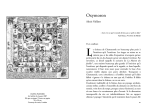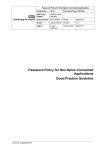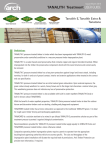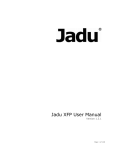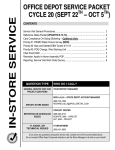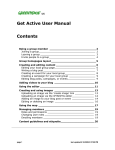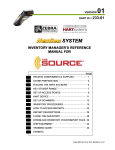Download Parliamentary papers guidance
Transcript
Parliamentary papers guidance A guide to producing and publishing Command, House of Commons and un-numbered Act Papers (Last updated September 2015) © Crown copyright 2014 This publication is licensed under the terms of the Open Government Licence v3.0 except where otherwise stated. Any queries regarding this publication should be sent to [email protected] This publication is available for download at nationalarchives.gov.uk. Parliamentary papers guidance Contents Introduction .................................................................................................................................... 4 The role of The National Archives .............................................................................................. 4 Types of Parliamentary paper ........................................................................................................ 5 Numbered Command Papers ..................................................................................................... 5 Independent reviews and reports ............................................................................................... 6 Why is publishing as a Command Paper important? .................................................................. 6 Un-numbered Command Papers................................................................................................ 6 House of Commons Papers ....................................................................................................... 7 Un-numbered Act Papers ........................................................................................................... 7 Command Paper requirements ...................................................................................................... 8 Should a document be a Command Paper? .............................................................................. 8 Obtaining a Command Paper number .................................................................................... 8 Selecting a title for a Command Paper ................................................................................... 9 Formatting and laying of Command Papers ........................................................................... 9 The Command Paper presentation line ................................................................................ 10 Using the Royal Arms ........................................................................................................... 10 Laying format ........................................................................................................................ 10 Laying outside Westminster .................................................................................................. 10 Publication ............................................................................................................................ 10 Contract services ......................................................................................................................... 11 The Print Vendor Partner Contract (PVP) ................................................................................ 11 Print copies ........................................................................................................................... 11 Production and distribution services ..................................................................................... 12 The ‘distribution-only’ option ................................................................................................. 12 Useful contacts ............................................................................................................................ 13 October 2014 Page 2 of 30 Parliamentary papers guidance Parliamentary papers planning .................................................................................................... 15 Who to consult? .................................................................................................................... 15 Production ................................................................................................................................ 16 Publication and despatch ......................................................................................................... 17 Controlling costs and schedules ............................................................................................... 18 Production and publishing flowchart and planning checklist ..................................................... 19 Annual reports and accounts ....................................................................................................... 20 Checklist ................................................................................................................................... 20 How copyright applies .................................................................................................................. 22 Crown copyright ....................................................................................................................... 22 Copyright and Parliamentary Papers produced by non-Crown bodies ..................................... 22 Laying and publishing a paper ..................................................................................................... 23 Checking that a paper has been laid ........................................................................................ 23 Publishing the paper................................................................................................................. 23 Risks associated with not publishing documents correctly on GOV.UK ................................ 25 GOV.UK exceptions ................................................................................................................. 26 Additional publishing information for un-numbered Act and un-numbered Command Papers . 26 Publication and the evolution of policy ..................................................................................... 26 How to correct a paper................................................................................................................. 27 Stickering ................................................................................................................................. 27 Correction slips......................................................................................................................... 28 Withdrawing and re-laying a paper ........................................................................................... 28 Costs to correct a paper ........................................................................................................... 29 After publishing a paper ............................................................................................................... 30 October 2014 Page 3 of 30 Parliamentary papers guidance Introduction This guidance will help you to understand the process of producing parliamentary papers, including Command, House of Commons and un-numbered Act papers. It explains the distinctions between the different types of papers, their significance in the parliamentary process and where to go for further advice and support. In the context of GOV.UK, these publications are referred to as ‘official documents’. The role of The National Archives The Controller of Her Majesty’s Stationery Office, an official operating within The National Archives, is responsible under a Letters Patent from Her Majesty The Queen for managing copyright on behalf of the Crown. The Letters Patent also confer upon the Controller the title of Queen’s Printer. The Queen’s Printer is responsible for setting the standards and overseeing the publication of certain government documents. These publications are: legislation statutory notices parliamentary papers, including Command and House of Commons Papers October 2014 Page 4 of 30 Parliamentary papers guidance Types of Parliamentary paper 'Parliamentary paper' is a term used to describe a document which is laid before Parliament. Most government organisations will produce at least one parliamentary paper per year. There are three categories of parliamentary papers covered by this guidance: Command Papers House of Commons Papers Un-numbered Act Papers The National Archives provides government organisations with guidance and information on publishing parliamentary papers. In addition, The National Archives is responsible for ensuring that services for the production of these documents are available to government organisations. The services are currently provided through the cross-government Print Vendor Partner Contract, managed by the Crown Commercial Service (previously the Government Procurement Service). Numbered Command Papers The requirements for Command Papers are set by the Controller of Her Majesty's Stationery Office, an official operating within The National Archives. Command Papers are documents that set out and describe government initiatives, the content of which will be of interest to Parliament. Papers are laid nominally by command of the Sovereign, but in practice by a Government Minister. The term Command Paper derives from the original wording carried on documents: 'Presented to Parliament by Command of His/Her Majesty'. Over time this wording has evolved, but the original wording is still used on a small number of documents. Command Papers form part of a continuous numbered series and cover a wide range of subject areas. Typically they include the following: major policy proposals ('white papers') consultation documents ('green papers') government responses to consultations responses to consultations (may be published as a summary document) independent reviews government responses to select committees certain departmental reports (not resource accounts) certain departmental reviews diplomatic documents such as treaties draft bills October 2014 Page 5 of 30 Parliamentary papers guidance reports of inquiries that are not to be published as House of Commons Papers may be published as Command Papers Independent reviews and reports High-profile independent reviews can also be published as Command Papers. If a large amount of media and public interest is expected, then the independent author and sponsoring department should consider formal publication of the report. Examples of independent reviews published as Command Papers include; Professor Löfstedt's review of health and safety legislation (Cm 8219) the review of the commercialisation and sexualisation of children (Cm 8078) the review of police officers' pay and conditions (Cm 8024) Please note that presenting a paper as a Command Paper does not imply that its contents have been endorsed or are supported by government, especially if the material has been produced by an independent body. Why is publishing as a Command Paper important? Publication of major government proposals and initiatives supports the democratic process and helps to ensure that government is transparent in its decision making. This is particularly the case where the issues raised could result in legislation or impact on public finances. Publishing documents that can be easily accessed and have been produced to known standards ensures that MPs, citizens and businesses can engage with, and scrutinise, the work of government. Command Papers therefore need to be published using standard publishing industry processes. The application of standard publishing processes helps users find papers long after a document is first published, so providing an audit trail of policy development and a historic record. The Command Paper series provides a continuous record of government thinking since midnineteenth century and is an invaluable resource for researchers. If the content of a report meets any of the criteria listed under Command Paper requirements then it should be published as a numbered Command Paper. Un-numbered Command Papers The vast majority of Command Papers are numbered. However, there are a few Command Papers that are un-numbered. The most significant examples are explanatory memoranda to October 2014 Page 6 of 30 Parliamentary papers guidance statutory instruments and the Queen's Speech. Other documents that may be published as unnumbered Command Papers are: Contingent liability minutes Treasury minutes concerning remission of outstanding debt, departmental minutes (regarding gifts to foreign countries, for example) explanatory memoranda to treaties (which are themselves laid as numbered Command Papers) reports of non-governmental bodies where government or Parliament has a major interest (such as the BBC's annual report and accounts) Other than these examples it is not usually appropriate to publish important documents as unnumbered Command Papers. House of Commons Papers House of Commons (HC) Papers are parliamentary papers that are laid before Parliament that have been ordered to be printed by the House of Commons. Many HC Papers are produced in response to a statutory requirement. HC Papers include departmental annual reports and accounts and National Audit Office reports. Statutory inquiry reports and other reviews may also be published as HC Papers. HC Papers form part of a numbered series that is administered by the Journal Office in the House of Commons. The specific format and laying requirements of the HC Paper series are overseen by the Journal Office. HC Papers are covered by parliamentary privilege. The Journal Office's detailed guidance on HC and un-numbered Act Papers is available on the Parliament website. Requests for HC numbers and other queries can be submitted to the Journal Office via email to [email protected] or by calling 020 7219 3361/3252. The Journal Office is the ultimate arbiter on whether a paper required to be laid by statute may be published as an HC Paper and therefore covered by parliamentary privilege. If you are unclear as to whether a paper should be an HC Paper, you should seek advice from your organisation's legal advisers before you contact the Journal Office. If required, some HC Papers can also be presented to the House of Lords by Command if 'Parliament' is replaced with 'House of Lords' in the standard Command Paper presentation line. You should check with your parliamentary unit if this is a possibility. Un-numbered Act Papers Sometimes known as 'Act Papers', these are documents that must be laid in Parliament by statute but do not form part of the numbered series of HC Papers. The Journal Office defines the October 2014 Page 7 of 30 Parliamentary papers guidance requirements for Act Papers, which, unlike HC Papers, are not subject to parliamentary privilege. You can obtain advice from the Journal Office on whether a document should be published as an un-numbered Act Paper. Command Paper requirements Command papers can cover a wide range of subjects, it is important to consider whether a document should be published as one at an early stage. Should a document be a Command Paper? In assessing whether a document should be published as a Command Paper, government organisations should use the criteria below, which also apply to cross-government reports, policy proposals and independent reviews: If the answer is yes to any questions below, then a document is a Command Paper: Will it prompt an Oral Statement in the House of Commons? Does it cover topics that might form the basis of a debate in Parliament? Is it a consultation paper on proposed policies that might lead to future primary legislation (for example, a draft bill) or a significant piece of secondary legislation? Will it include recommendations (for example, from a review or other inquiry) that might lead to the government bringing forward policy proposals or future legislation? Will it be of constitutional importance? Will it be of historical interest to researchers and likely to be included in library catalogues? Government departments' parliamentary units can usually advise as to whether a document should be published as a Command Paper. However, if there is any doubt, please contact The National Archives for advice. Command Papers do not attract parliamentary privilege. Therefore, if the content is of a sensitive nature, or includes criticism of individuals, you should consider publishing the document as an HC Paper. In such cases government organisations should first consult their legal advisers and then seek the views of the Journal Office as soon as possible. Obtaining a Command Paper number Government departments obtain Command Papers numbers from The National Archives. To request a number you will need to provide details of the document's title and proposed laying date. The laying date will generally be the same as the document's publication date. Please note that publication of documents before they have been laid before Parliament is considered discourteous. Numbers are issued up to a month in advance of publication. They can be issued October 2014 Page 8 of 30 Parliamentary papers guidance on the basis of working titles. However, you must inform The National Archives when the title has been finalised. If, for whatever reason, the publication of a Command Paper is postponed or cancelled, you must inform The National Archives so that it can reallocate the number. Please email [email protected] to request a number. Numbers required urgently can be obtained by calling 020 8392 5218. Selecting a title for a Command Paper The best titles to use are those that state clearly the content or purpose of the paper. The National Archives strongly advises that the terms 'green paper' or 'white paper' are not used within the title. This is because these terms do not have any formal definition in the context of official publications and their use may lead to confusion. Formatting and laying of Command Papers While decisions about the design of Command Papers are left to the originating government organisation, you must follow some standard format and styling requirements so that the papers can be laid before Parliament. Command Papers are A4 (297x210mm) portrait, although landscape maps or diagrams may be included. They also have a title page (page 1) which has: the Royal Arms at the top the correct presentation line for Command Papers the Command Paper number text that is ideally 12pt, but at least 10pt They have a title verso page (page 2) including: a current copyright and re-use statement the web and print ISBNs text indicating availability on www.gov.uk recycled paper content; printer line In addition they: have a contents page (page 3) which will help users navigate the paper have a back cover including the print barcode are laid as print copies October 2014 Page 9 of 30 Parliamentary papers guidance The Journal Office may refuse to accept documents for laying which do not meet these requirements. The Journal Office has produced detailed guidance on the procedures for laying parliamentary papers. The Command Paper presentation line The presentation line is included on the paper's the title page and follows this formula: 'Presented to Parliament by [minister/s titles] by Command of Her Majesty' Using the Royal Arms The Royal Arms must appear at the top of the title page without the department's name. No text or other imagery may appear above the Royal Arms and nothing may be superimposed over them. Read about the government identity system. Laying format Papers must be laid as printed copies, accompanied by an appropriate cover letter. The Journal Office will not accept electronic copies for laying purposes. Laying outside Westminster Most Command Papers are laid before the UK Parliament. However, in certain circumstances a paper may need to be laid before the legislatures of Scotland, Northern Ireland and/or Wales. If additional presentation is required, the paper should carry an appropriate presentation line and may also need to carry an additional series number. For further information, in the first instance please contact the parliamentary unit of your organisation, or that of its parent department. Publication Command Papers must published on GOV.UK after they have been laid before Parliament. Papers should not be published in hard copy or digitally prior to laying. October 2014 Page 10 of 30 Parliamentary papers guidance Contract services A range of services are provided under contract to help government organisations make sure that their parliamentary papers are produced to the required standard. The Print Vendor Partner Contract (PVP) The National Archives is responsible for ensuring that services to produce documents for publication are available to government organisations. These services are currently provided through the cross-government Print Vendor Partner Contract (PVP), let to the Williams Lea Group and managed by the Crown Commercial Service (CCS). To access PVP contract services for parliamentary papers, organisations must formally join the PVP contract if they have not done so already. This is a brief administrative process facilitated by the CCS. For further information on the process please contact a CCS Print Category representative or call the CCS Service Desk on 0345 410 2222 well in advance of using contract services for the first time. Please also contact the CCS with any queries about the PVP contract’s fees and charges. With some exceptions it is possible to use as many, or as few, of the services offered under the PVP contract as necessary. In line with CCS requirements, it is possible to continue to use inhouse services or purchase services such as design, typesetting and/or print services elsewhere and combine them with the PVP contract’s services. Print copies Print copies of Command and House of Commons Papers must be produced for laying, statutory legal deposit and any other requirements set by HM Treasury, organisations’ parent departments, or select committees. Where the PVP contract has been used by an organisation to print their documents, the contractor will produce print copies for Members of Parliament at no cost to the organisation. If the PVP contract is not used for print copies, organisations must supply their document’s print copies to the PVP contractor for onward delivery into Parliament and to legal deposit libraries. In such cases, please liaise with the contractor at the earliest opportunity to confirm that the document includes the required publication furniture and that up-to-date delivery information is obtained. See the ‘distribution-only’ option for further information on the steps required when the contractor’s print services are not being used. The PVP contractor will provide production and distribution services to ensure that the official versions of parliamentary papers are produced to standard. The distribution services must be used for House of Command and Command Papers. The services are optional for un-numbered October 2014 Page 11 of 30 Parliamentary papers guidance Act Papers and un-numbered Command Papers and organisations may find the additional support useful. Production and distribution services The production and distribution services include: expert advice about papers’ production and distribution specifications and processes provision of quotations and timelines provision and assurance of publication furniture including web and print ISBNs, and Crown copyright statements publication furniture proofing managing proofing and sign-off of content (if using PVP print services) demand management of print copy quantities print management (if using PVP print services) provision of copies of print-ready PDFs and web-optimised PDFs (if using PVP print services) online notification of laid papers facilitation of the delivery of print copies for Parliament bibliographic and information services delivery of one print copy to each of the six Legal Deposit Libraries delivery of one print copy to The National Archives facilitation of three print copies for the contractor access to other services, such as reprints and services to correct papers The ‘distribution-only’ option If an organisation has not used the contractor’s services to produce and print its document, then it will be necessary to use the PVP contract’s distribution-only option which includes the relevant services above. This will ensure that print copies of documents are available for Members of Parliament after laying and are distributed to the legal deposit libraries. Organisations using this option will need to contact the contractor to: obtain and check the inclusion of print and web ISBNs and print ISBN barcode check the inclusion of the most up to date Crown copyright and re-use statement if applicable ascertain the number of print copies to be delivered to the contractor ascertain the date and time print copies should be delivered, generally on the working day before laying obtain labelling, packing and delivery instructions deliver appropriately labelled and packaged print copies to the contractor October 2014 Page 12 of 30 Parliamentary papers guidance Useful contacts There are a number of organisations who set standards, provide guidance and services related to the production of a parliamentary paper. Who Area of advice Contact details Government organisations The National Archives Command Paper numbers and requirements [email protected] 020 8392 5218 Publishing advice including the use of appropriate copyright and re-use statements Information on HM Government identity system and branding Cabinet Office Crown Commercial Service Government Digital Service Information on using the PVP contract and contract fees and charges Manages GOV.UK Information on making web PDFs usable and accessible [email protected] communication.cabinetoffice.gov.uk/hmg Contact existing departmental Crown Commercial Service Print Category team contacts or call 0345 410 2222 Contact existing Government Digital Service contacts (which maybe through a parent department if applicable) or email [email protected] https://www.gov.uk/service-manual/usercentered-design/resources/creatingaccessible-PDFs.html Office of Disability Issues Information on making publications accessible for disabled people odi.dwp.gov.uk/ Suppliers PVP contractor Command and House Papers Service Delivery Team Production services (print, creative and distribution) 1.1. [email protected] 1.2. 020 7394 4571 1.3. Organisations should continue to liaise with their usual Command and House Papers contact on [email protected] or contact their Williams Lea Account Manager. Any initial queries about using the PVP contract and its charges and fees should be put to the Crown Commercial Service. October 2014 Page 13 of 30 Parliamentary papers guidance Other suppliers Production services as necessary Parliamentary offices Journal Office House of Commons Paper numbers and requirements [email protected] 020 7219 3361/3252 Un-numbered Act Paper requirements Guidance on laying parliamentary papers Advice on laying procedures Vote Office Distributes print copies of papers to members of the House of Commons Printed Paper Office Distributes print copies of papers to members of the House of Lords The PVP contractor is responsible for liaising with the Vote and Printed Paper Offices on the number of print copies they require. Generally, it should not be necessary for organisations to contact these offices directly on parliamentary papers. For Annual Reports and Accounts, it may be necessary to consult the following organisations for advice: Parent department (relevant to arm’s length bodies) HM Treasury (generally central government departments and trading funds only) National Audit Office Audit and accountancy services suppliers October 2014 Page 14 of 30 Parliamentary papers guidance Parliamentary papers planning Parliamentary papers can be complex; it is important to plan the document’s production thoroughly and keep everyone involved informed of changes to the production schedule. This section explains in more detail the various stages and issues that you should consider. Government organisations should also consult any in-house publishing guidance and/or information provided by their parent department. Some papers are relatively complex, such as annual reports and accounts, and statutory inquiry reports, where further guidance will apply. In addition, it may be necessary to factor in an organisation’s own procedures and where responsibilities sit within different teams. In general, it is best to start planning and liaising with colleagues and potential suppliers as early as possible. Who to consult? In addition to those responsible for drafting the paper, input may be required from other teams within and outside a government organisation. Within an organisation, you may need to consult parliamentary, communications and/or publishing teams to confirm that a paper is being produced, the expected date of publication and to discuss any media publicity or digital engagement that may support the paper. You may also need to seek external advice from a number of organisations. Once there is agreement to publish a parliamentary paper, keep everyone involved informed of progress or any potential issues. Ensure that key contacts, including suppliers, have your up-todate contact details. Gather cost estimates or quotes You should also obtain the necessary sign-off from the budget-holder for the likely total cost of the project. On request, the paper also needs to be available in Braille, large print, audio or British Sign Language, so include these in the plan and budget. Establish the project's time frame Agree a schedule that allows enough time to circulate and check proofs. Overrunning projects mean greater expense. October 2014 Page 15 of 30 Parliamentary papers guidance Ensure the commissioning agreement assigns the resultant copyright in the document to the Crown You must do this if an external author is being used to write a report, for example an independent review. Plan and agree the report's content Does the government organisation have a drafting template or branding guidelines for major reports? Are there graphs, photographs, logos or other items? Do you have permission to use any third party copyright material? If there are photographs of identifiable individuals, have they signed a 'model release'? Production Typesetting and printing the document and/or creating print and web PDFs Will the report be printed in colour? Or in black and white (monochrome - which is cheaper than colour)? Identify any professional services required to typeset the document and/or to create print and web PDFs. Is this done in house? Most organisations publish their parliamentary papers in PDF format. To comply with Government Digital Service policy on open document formats organisations should be working to ensure that PDFs published on government websites adhere to the requirements for viewing government documents. The National Archives is liaising with the Crown Commercial Service to see whether PDFs produced for parliamentary papers through the PVP Contract adhere to these requirements by default. Does a summary, or all of the report, need to be translated into Welsh? Is an Easy Read edition required? Producing papers over 32 pages long Remember that papers over 32 pages long need a separate cover. Covers of papers published through the contract must not be laminated. This is because laminated covers are not recyclable. Allow sufficient time Ensure that there is enough time to proof read the document for typographical and/or other errors before submitting the final file to print Ensure that the suppliers are aware that the paper will be laid in Parliament. This will allow them to better manage their resources to assist October 2014 Page 16 of 30 Parliamentary papers guidance Allow time for ministerial submission and clearance. Cross-departmental approvals take longer and need to be factored into the schedule Suppliers and colleagues need to be kept up to date with changes in the schedule. Some schedules may require out-of-hours working, which will change/increase costs and may require another spending approval Please note that due to the practicalities of the print production process there will be a time beyond which a print schedule cannot be reduced further. In addition, while there may be sufficient time to print a paper, during busy times a supplier may not have enough capacity to print and deliver print copies to a fixed deadline, particularly when a paper's sign off has been delayed Written Ministerial Statement or Oral Statement Confirm with the relevant parliamentary unit whether a Written Ministerial Statement or Oral Statement will be used to announce the laying of the document to the House. Submission to a select committee Check whether the paper must be submitted to a select committee prior to publication. Check how many print copies are required The contractor will supply copies to Vote Offices for MPs at no cost to you, so you don't need to count and pay for MPs' copies unless you have chosen the 'publish-only' option. How many copies are required by your organisation for laying, its select committee, the organisation's own use and for distributing to stakeholders? Remind colleagues that it is cheaper to email a URL instead of sending everyone a printed copy. Is a cover letter required for stakeholder copies? Is the stakeholder list complete? How will the organisation's printed copies be mailed out? Have the distribution costs been budgeted for? Publication and despatch Allow enough time to submit the final file to print, and for printing, binding, packing and despatch of printed copies. Contact your organisation’s digital team, or that of your parent department to alert them that you are planning to publish a document on GOV.UK Ensure that both the print-ready PDF and web-optimised PDF have been passed to your digital team, or that of your organisation’s parent department if you do not have access to GOV.UK, October 2014 Page 17 of 30 Parliamentary papers guidance ahead of the document being laid. This will help to minimise the time between laying and subsequent publication on GOV.UK. Some documents’ files will include more than one weboptimised PDF and one print-ready PDF. Remember that some PDFs could be large files. There may be restrictions on the size of files that can be sent and received by email in your organisation. If these limits apply other arrangements will need to be made to ensure that the files are received in time for prompt publication. Alternatives to email could include the use of memory sticks/courier or your supplier’s FTP site. In addition, some organisations’ shared email accounts may allow larger files to be received than personal email accounts. Ensure that the arrangements provide the appropriate level of security and if this is unclear consult with your organisation’s security officer. Remember, the paper cannot be published online or otherwise distributed digitally or in hard copy until it has been laid before Parliament. Generally, publication should take place as soon as possible after laying. The version published online must be exactly the same as the version laid before Parliament. When published on GOV.UK, the document must be accompanied by the appropriate publication metadata. Controlling costs and schedules There are a number of steps that government organisations can take to keep down the production costs of parliamentary papers. Consider these if a paper is being produced to a very tight schedule: Use monochrome (black and white) throughout which is cheaper and quicker than colour. Avoid grey tints and photos - in other words - keep any images such as graphs to black and white lines or dots so that the document can be printed on uncoated (cheaper) paper Opt for colour only if colour images or graphics are necessary for understanding the content of the paper If the paper is being typeset, avoid high correction charges by ensuring the text is as final as possible before it is sent to an external typesetter Produce black and white documents in Word to remove the need for a typesetter. If you have the appropriate Adobe software, and the skill, produce web and print PDFs from the Word file. Or the contractor can produce them for you for a fee Avoid trying to produce print PDFs directly from colour Word documents - have colour documents typeset. This ensures that colours, bleeds and so on are correctly specified for printing Avoid solid opaque ink coverage over large areas. The print technology used for short print runs can result in the finish of printed documents being poor. Large areas of colour can also take longer to dry Aim for extents fewer than 72 pages. Papers longer than 72 pages have additional binding requirements that increase cost and production time October 2014 Page 18 of 30 Parliamentary papers guidance Keep the number of print copies required as low as possible. Additional copies increase the overall cost and take longer to produce. After the document has been laid and published, email the paper's URL instead of posting printed copies to the stakeholders Production and publishing flowchart and planning checklist The National Archives and Department for Transport have produced a production and publishing flowchart. The flowchart provides a detailed breakdown of the steps involved in the production and publication of parliamentary papers, particularly Command Papers. Not all documents or organisations will include all of the steps outlined here; for example not all papers will include third-party copyright photographs. In addition, some organisations' documents are produced in an in-house Word template which may mean that there is no need to purchase typesetting services. The flowchart will assist those who have no or limited publishing experience and can help ensure that no important steps are missed: Parliamentary papers production flowchart (XLS, 0.10Mb) October 2014 Page 19 of 30 Parliamentary papers guidance Annual reports and accounts Generally government organisations' annual reports and accounts are published as House of Commons (HC) or un-numbered Act Papers. The Journal Office sets the requirements for these parliamentary papers. Contact the office at [email protected] or call 020 7219 3361/3252. Much of the production and publishing information provided applies equally to annual reports and accounts. However, these papers have additional clearance procedures, and organisations may need to check with their parent department or, if a central government department, with HM Treasury to ensure that the correct processes are followed. You must factor in the additional clearance procedures when planning the production of annual reports and accounts. Checklist Government organisations have their own detailed project plans to produce the report and accounts - this summary highlights some of the steps involved. Government organisations may need to consider these: Central departments should follow guidance from the HM Treasury Ensure any standing templates are updated to reflect current guidance. Do not assume that previous years' templates will still be correct Identify and plan the National Audit Office input* Executive agencies and other arms-length bodies should prepare annual reports and accounts in accordance with their governing documents, relevant legislation and directions given by parent departments Executive agencies and other arms-length bodies should confirm with their parent department the timelines for approval by the permanent secretary and relevant minsters Obtain a spending controls exemption to produce and publish the report and accounts Combine draft text and financial information Confirm whether the design and layout of the report and accounts will be managed in house or given to an external design agency or typesetter Review and agree on the design and layout of the document Departments must obtain and include an HC number from HM Treasury. In some cases parent departments can obtain HC numbers for other organisations. Otherwise obtain numbers directly from the Journal Office Check that the presentation line in the document is correct. If the report and accounts is an HC or Act Paper ensure that it is laid under the correct piece of legislation, consult October 2014 Page 20 of 30 Parliamentary papers guidance with legal advisors if there is any doubt. It is the authoring organisation's responsibility to ensure that the laying authority is correct Obtain and include the necessary publication furniture including ISBNs, print ISBN barcode, copyright and re-use statement from the PVP contractor and submit the completed cover, title page and title verso to the Journal Office for approval Liaise with external auditors to audit accounts. Bear in mind that more than one audit may take place Review and manage report and accounts drafts leading up to final approval to publish Ensure that the document has been proof read for typographical errors and to ensure that the correct copyright statement, ISBNs and barcode have been included before sending the document to the printers Obtain final approval from relevant organisations (such as external auditors and parent department) to publish Confirm how many print copies are required If the publishing contractor is not being used to supply print copies, agree a print copy delivery date with the contractor. Obtain packing and labelling requirements Send final print file to your print supplier HM Treasury lays central departments' annual reports and accounts. Departments should liaise with HM Treasury to ensure that copies of the report and accounts have reached the Treasury in time to meet the planned laying date Executive agencies and other arms-length bodies should liaise with HM Treasury, or their parliamentary unit or that of their parent department, to ensure the report is laid in Parliament Organisations without access to GOV.UK should liaise with their parent department’s digital team to ensure that the web PDF and print PDF of the annual report and accounts is published on GOV.UK Remember, the version published online must be exactly the same the version laid before Parliament Ensure that a web-optimised and a print-ready PDF of HC Papers, is published on GOV.UK as soon as possible after laying. Please note that some documents may have more than one web-optimised PDF and one print-ready PDF. There should not be a long delay between laying and publication *The NAO has prepared checklists which document all of the matters that should be addressed, where appropriate, in a set of annual reports and accounts. You or your colleagues should look at these checklists in advance to ensure that the timetables for laying accounts are not delayed because of omissions in the accounts. The NAO has also published a two page guide on governance statements. This guide has been prepared by reviewing a number of departments and arm's length bodies across government and drawing out some of the key messages arising from the first year implementing the governance statements. You should engage with governance colleagues to ensure that the governance statements in their annual reports and accounts adhere to best practice. October 2014 Page 21 of 30 Parliamentary papers guidance How copyright applies Copyright applies to parliamentary papers and must be indicated on a paper's title verso page (page 2). Placing the statement on the title verso page is standard publishing industry practice. The National Archives publishes guidance on the appropriate copyright and re-use statements to include in parliamentary papers and in other government publications. The statements allow for the owner of the copyright and the year that the paper is first published to be clearly identified and give the terms under which the content can be used by others. Crown copyright Most documents and website content produced by civil servants will be subject to Crown copyright. If a government organisation has commissioned a third party to author a document, for example an independent review or research, it should ensure that the copyright in the work is assigned to the Crown. To this document the government organisation should add the appropriate copyright and re-use statement. Further information relating to commissioning agreements and copyright is available in Publishing: a guide for government organisations. Using the appropriate statement allows the re-use of government information, both Crown and non-Crown, through the Open Government Licence. Copyright and Parliamentary Papers produced by non-Crown bodies Organisations which own their own copyright are encouraged to make their information available for use and re-use with the minimum of obstacles. This will contribute to greater transparency and openness and ensure that important documents are disseminated to as wide an audience as possible. One of the easy ways in which this can be achieved is by referencing the Open Government Licence in the copyright statement. Copyright statements for both Crown and non-Crown bodies can be found in Copyright statements in official publications. You can find further information about the Open Government Licence on our website. Publishing: a guide for government organisations October 2014 Page 22 of 30 Parliamentary papers guidance Laying and publishing a paper Government organisations are responsible for ensuring that parliamentary papers are published correctly on GOV.UK. This section explains the steps that organisations need to take to ensure that end users can access their publications. Checking that a paper has been laid Parliamentary papers must be laid in the Journal Office before they are published or otherwise distributed. The act of laying is undertaken by your department's parliamentary clerk, or that of your parent department. Some annual reports and accounts however are laid by HM Treasury. Publishing before laying is considered discourteous to the House of Commons. Securely wrapped hard copies may be distributed under embargo before a document is laid, however the copies must not be unwrapped until after laying has taken place. You can check whether your organisation’s document has been laid by speaking to your department’s parliamentary clerk. In addition, notification of laying is available through the Journal Office System. Organisations can also confirm the laying of documents by referring to the Votes and Proceedings for the day on which the document was due to be laid in the House of Commons. The Votes and Proceedings can be found on Parliament's website. Publishing the paper Organisations must publish their Command, House of Commons or un-numbered Act Paper on GOV.UK on the same day that it is laid before Parliament. The version published on GOV.UK should be the same as the version laid in Parliament. Organisations may co-ordinate publication so that it coincides with a major announcement or policy launch. It is the authoring organisation’s responsibility to ensure that the paper is published on GOV.UK. This requirement applies to papers published by organisations listed on GOV.UK. It also applies to organisations which have an exemption from publishing other content on GOV.UK. Exempt bodies will need to liaise with the digital teams in parent departments to arrange publication. It is strongly recommended that exempt bodies identify the appropriate contacts in advance of the paper being laid in Parliament. In the context of GOV.UK, Command, House of Commons and un-numbered Act Papers are referred to as ‘official documents’. The documents’ web-optimised PDF and print-ready PDF need to be published on GOV.UK. Web-optimised PDFs should meet Government Digital Service guidelines on creating accessible October 2014 Page 23 of 30 Parliamentary papers guidance PDFs. More information can be found in the Government Service Design Manual. For a fee, the PVP contractor and other suppliers can provide services to create an accessible PDF. Most organisations publish their parliamentary papers in PDF format. To comply with Government Digital Service policy on open document formats organisations should be working to ensure that PDFs published on government websites adhere to the requirements for viewing government documents. The National Archives is liaising with the Crown Commercial Service to see whether PDFs produced for parliamentary papers through the PVP Contract adhere to these requirements by default. Organisations must obtain print-ready PDFs from their printer. The print-PDF is the file used by the printer to produce the copies that your organisation, or parent department will lay in Parliament. The publication of the print-ready PDFs will allow any supplier wishing to sell professionally printed copies to the public to do so. There is no official contracted print publisher, although organisations will be able to obtain print copies from their printer to give stakeholders or to use at press launches. Organisations should time the receipt of documents’ final web-optimised PDFs and print-ready PDFs so that GOV.UK publication can take place on the same day as the document is laid before Parliament. It is strongly suggested that both web PDFs and print PDFs are received before laying to expedite publication. Parliamentary papers PDFs published on GOV.UK need to include specific metadata. Including the correct metadata, as advised by Government Digital Service, will ensure that your document can be found by the GOV.UK search functionality for official documents. The web-optimised PDF metadata includes the document’s: web ISBN HC number/Parliamentary Session or Command Paper number (where appropriate) https://www.gov.uk/how-to-buy-printed-copies-of-official-documents in the ‘Order URL’ field, with the price field left blank Print PDFs of official documents uploaded to GOV.UK should include the: document’s title in the relevant metadata field with ‘(print-ready PDF)’ inserted after the title print ISBN HC number/Parliamentary Session or Command Paper number It is suggested that the print PDF appears underneath the web-optimised version. October 2014 Page 24 of 30 Parliamentary papers guidance When supplying the PDFs to digital teams you should include the print and web ISBNs, Cm number or HC number and Parliamentary Session years in the covering email. Organisations may also wish to supply extra explanatory text to include on the document’s page on GOV.UK. Further information on the metadata to be added can be found in the GOV.UK Publisher Manual. Publication metadata, such as the ISBN, HC number or Command Paper number are unique to particular publications. This information is used by researchers, students and librarians to identify specific publications, therefore it is important that it is included with every document published on GOV.UK. When uploading House of Commons Papers organisations must ensure that the correct Parliamentary Session is selected. For annual report and accounts, the Session that a document is laid in will not always be the same as the financial year that the report covers, For example; HM Treasury’s 2013-2014 annual report and accounts was laid in the 2014-2015 Parliamentary Session. Including the wrong Parliamentary Session can create difficulties for users trying to locate your document. If there is any doubt consult your organisation’s parliamentary unit or check the Parliamentary recess dates These documents may also be published in on GOV.UK in additional formats and on organisations own websites, where they exist. If a paper has been distributed through the PVP contract, bibliographic information about the document will be available to users and statutory legal deposit (in print) will be undertaken on the organisation’s behalf. Risks associated with not publishing documents correctly on GOV.UK Failure by organisations to publish promptly will result in the public, media, third-sector or businesses being unable to access the information. Details of documents laid before Parliament are publically available, therefore users of these documents expect to be able to find these documents once they have been laid. Failure to publish promptly may result in the content of documents being discussed in the media, but the wider public being unable to access the information. Organisations contact centres may also receive enquiries requesting copies of a document’s PDFs if these have not been made available on GOV.UK. October 2014 Page 25 of 30 Parliamentary papers guidance GOV.UK exceptions Print-ready PDFs do not need to be uploaded to GOV.UK for un-numbered Act or un-numbered Command Papers. However, if these PDFs are available please consider whether their inclusion would be helpful for end users. A few organisations which produce House of Commons and un-numbered Act Papers should not publish documents on GOV.UK. This is because in the context of GOV.UK, they are not considered to be government organisations. These organisations are the: National Audit Office Electoral Commission Local Government Boundary Commission England Independent Parliamentary Standards Authority House of Commons and House of Lords medical professional bodies overseen by the Privy Council Office. Instead, these organisations should ensure that their papers are published on their own corporate websites, ensuring that papers' copyright statements refer availability on their own website instead of referencing GOV.UK. Additional publishing information for un-numbered Act and un-numbered Command Papers If an organisation is producing an un-numbered paper without using the PVP contract's services please ensure that the correct copyright and re-use statement is included within the document. Please also ensure that statutory legal deposit obligations are met by submitting printed copies of the document to the legal deposit libraries. Please see the Journal Office guidance for other information relating to un-numbered Act Papers. Publication and the evolution of policy Command and House of Commons papers must be published on GOV.UK. Information included when the documents are uploaded will ensure that users will be able to search for documents across the entire body of papers. As policies and priorities change, previously published Command or House of Commons papers may be superseded. Organisations should never remove superseded documents from GOV.UK. October 2014 Page 26 of 30 Parliamentary papers guidance This will result in the paper no longer being searchable. If a document is superseded, organisations should archive the GOV.UK page which the document was originally published on. Alternatively, if the superseded document appears on a page with other material which is current, create a separate standalone page for the document and archive that. This will ensure the document remains available but will make it clear that the content no longer reflects current policy. How to correct a paper Errors in parliamentary papers are rare but there are services available to help correct a document appropriately. If an error or omission is noticed in a parliamentary paper once it has been laid, government organisations need to contact the Journal Office and the PVP contractor as a matter of urgency. Organisations with parent departments must also inform their parent departments of errors or omissions contained within laid documents. As a published paper must be the same as its laid version, organisations must not amend the online version without publishing a correction slip. An amendment can be included in several ways, depending on the change required: ‘stickering’ a correction slip (sometimes known as an erratum slip); or withdrawing and re-laying the paper Any of these options may involve additional cost. Where possible, to minimise the cost, corrections should be dealt with before print copies are despatched to Parliament or stakeholders. Stickering ‘Stickering’ can take place if a minor error is identified after a document has been professionally printed, but generally prior to it being laid. If this is the case, the print copies (including the laid copies and those to be distributed on publication, where not already despatched from the contractor) should have a sticker with the correct text placed over the erroneous text. The online versions of the document including web-optimised PDFs and print-ready PDFs should also be corrected before publication. October 2014 Page 27 of 30 Parliamentary papers guidance Correction slips Correction slips should be used where an error or omission is noticed after laying has taken place. Correction slips should be issued to Parliament and will include information related to the publication being corrected, and stating the text that is being corrected. Correction slips are usually used to correct typographical errors rather than factual inaccuracies. To ensure correction slips include the relevant publishing information, The National Archives provides correction slip templates for House of Commons and Command Papers ready for organisations to complete. Examples of filled out correction slips are also available. Blank templates can also be obtained from the PVP contractor. Organisations must obtain Journal Office approval before correction slips are distributed in print or online. Organisations must also ensure that the correction slip is uploaded where the paper is published online, including GOV.UK. It is recommended that organisations embed correction slips in papers’ web and print PDFs to ensure that the corrected information is not missed by users. Organisations will also need to indicate that the content of the PDFs has been updated through the ‘public change note’ on the document's page GOV.UK. In addition, printed correction slips must be distributed to the legal deposit libraries, and Parliament. The PVP contractor provides services to government organisations to ensure that this distribution and the issuing of updated bibliographic data takes place. Organisations should also ensure that correction slips are sent to stakeholders provided previously with print copies to ensure clarity on the document's final content. Withdrawing and re-laying a paper If the error or omission is significant, it may be necessary to withdraw and re-lay a new version of the paper. October 2014 Page 28 of 30 Parliamentary papers guidance If the decision is taken to re-lay a withdrawn paper government organisations should ensure that the re-laid version has a new set of ISBNs. If a Command Paper is withdrawn and re-laid, then government organisations should request a new Command Paper number from The National Archives as well. If a House of Commons Paper has been withdraw and re-laid, then the Journal Office should be consulted on whether a new HC number is required. The application of new ISBNs and paper number will help users to distinguish between the different versions of the paper. In addition, a re-laid version of a paper should contain additional text on the title page explaining briefly that it is a new version of a previously laid and withdrawn document. The PVP contract provides services to support this process including replacement bibliographic data and legal deposit arrangements. If it is decided to withdraw a paper without re-laying another version the PVP contract provides services to cancel previously issued bibliographic data and the withdrawal of legal deposit copies. Costs to correct a paper If the error is the fault of the government organisation, it will be liable for any additional costs involved. If the error is the fault of a supplier then it will be liable for the costs involved. It is the responsibility of the authoring organisation to check the final proof of a paper and approve it for laying and publication. October 2014 Page 29 of 30 Parliamentary papers guidance After publishing a paper Once a parliamentary paper has been produced organisations should review the process. Think about your organisation more broadly and the needs of colleagues who may be required to produce documents in future: consider what went right and what needs to be managed differently in the future check whether any guidance needs to be updated, including The National Archives' publishing guidance, and advise those concerned share information with colleagues to inform future papers ensure relevant colleagues (including those in other public sector organisations) and suppliers are on The National Archives’ contact list for its guidance updates October 2014 Page 30 of 30






























![KSC-510CTR - [::] Kenwood ASC](http://vs1.manualzilla.com/store/data/006761313_1-61614c02bef0e6817b720e64150dd007-150x150.png)
